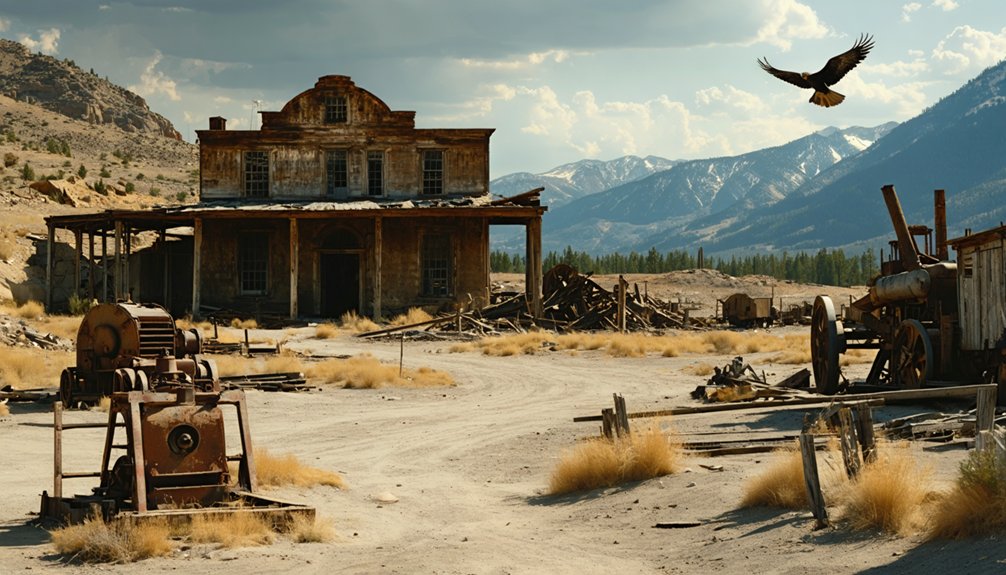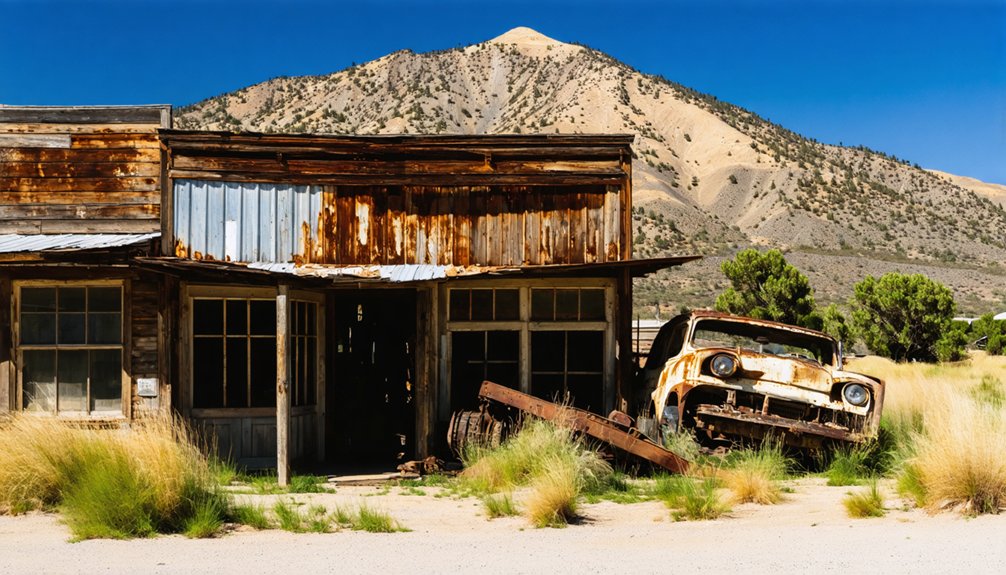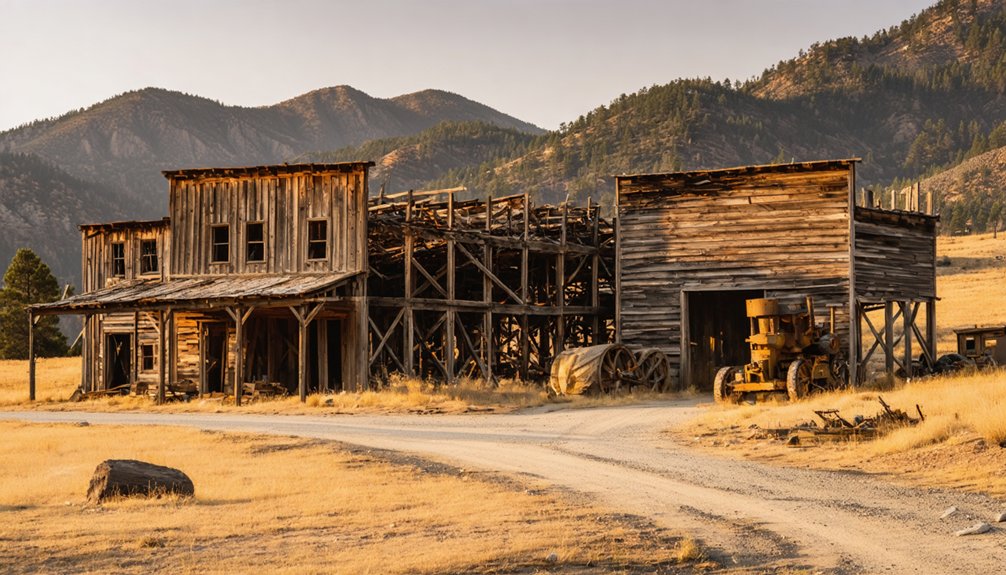Mount Ophir was once a thriving Gold Rush town in California that flourished after Mexican miners discovered gold in 1848. You’ll find it situated at 2,051 feet elevation in Mariposa County, where it reached a peak population of 5,000 residents. The settlement featured an assay office, trading post, and mining operations that yielded over $300,000 in gold before legal disputes and resource depletion led to its abandonment. The stone ruins still whisper tales of California’s golden past.
Key Takeaways
- Mount Ophir was a thriving Gold Rush town established in 1851 that reached a peak population of 5,000 before decline.
- The town’s prosperity came from rich gold deposits, with the Mount Ophir Mine producing over $300,000 in the 1850s.
- Legal disputes over mining claims led to operations halting after an 1866 Supreme Court decision favoring Frémont’s ownership rights.
- Visitors today can explore ruins including a distinctive two-story stone trading post built in 1853 from locally quarried schist.
- Despite local legends, Mount Ophir never operated as a mint, with the famous gold slugs actually produced in San Francisco.
The Origin Story: From Ophir to Mount Ophir (1850-1856)
When gold was first discovered by Mexican miners in the area in 1848, few could have predicted the rapid transformation that would follow in this small corner of California’s gold country.
The area’s Ophir origins began with its Biblical naming around 1850, replacing its earlier designation as “Spanish Corral” and reflecting the rich placer deposits that yielded an astonishing $217,000 in a single week. Like the legendary Mount Ledang in Malaysia which Chinese seafarers called Kim Sua, California’s Mount Ophir became known for its golden promise.
The Merced Mining Company established the Mount Ophir Mine in 1851, setting the foundation for the town that would soon develop around it.
Gold Rush Prosperity: Economic Impact and Mining Operations
You’ll find Mount Ophir’s prosperity emerged directly from its rich quartz veins, with operations like the Mount Ophir Mine generating over $300,000 in gold during the 1850s (equivalent to $11 million today).
The economic boom supported a population of 5,000 residents and established essential infrastructure including a 24-stamp mill, sawmill, and California’s first authorized mint for converting raw gold into official currency. The two-story trading post built in 1853 from locally mined schist became a vital commercial hub for the community. The ghost town now stands as another example of arrested decay, much like Bodie, preserving the tangible remnants of California’s mining history.
Despite creating substantial wealth that legitimized California’s gold commerce, the town’s fortunes became entangled in legal disputes as mining claims were contested and eventually faced decline as accessible gold deposits diminished.
Wealth From Stone
As Mexican miners struck gold at Mount Ophir in 1848, they unwittingly triggered an economic transformation that would reshape California’s landscape for decades to come. Their first week yielded an astounding $217,000, validating Mount Ophir’s prominence within the Mother Lode region.
You’d find gold extraction methods evolved rapidly once the Merced Mining Company established operations in 1851. Mining technology advanced considerably with the construction of a 12-stamp mill by 1852, revolutionizing quartz ore processing capabilities.
The investment paid dividends—the mine produced over $300,000 in gold during the 1850s alone. Operations continued profitably for decades, with the Mariposa Commercial & Mining Company taking ownership in 1897 and maintaining production through 1914. Located at an elevation of 2,051 feet, Mount Ophir offered miners strategic positioning within Mariposa County’s gold-rich terrain.
This sustained success funded robust infrastructure, including a slate-roofed trading post that served both miners and traveling merchants.
Boom and Legal Battles
Mount Ophir’s economic prosperity soared beyond simple wealth extraction to become a foundational pillar of Mariposa County’s development during the 1850s. The mine’s impressive $300,000 gold production fueled regional growth while advanced mining techniques transformed the settlement into a bustling hub with a 24-stamp mill, sawmill, and nearly fireproof trading post constructed of local schist. During its peak, Mount Ophir supported a thriving community with 5,000 residents enjoying amenities like stores and postal service.
Your freedom to stake claims faced economic challenges in 1855 when surveys placed Mount Ophir within Frémont’s land grant. The ensuing legal battle between the Merced Company and Frémont’s lessee Biddle Boggs halted operations after initial favorable rulings for miners were reversed.
The U.S. Supreme Court’s 1866 decision supporting Frémont’s ownership rights effectively ended the boom, with mining remaining dormant until 1897 when new investors briefly revived operations before final closure in 1914.
The Moffat Mint Mystery: Separating Fact From Fiction
You might be surprised to learn that the famous octagon-shaped $50 gold slugs attributed to Mount Ophir were actually produced at Moffat & Company’s private mint in San Francisco, not in Mariposa County.
Despite extensive archaeological searches yielding no evidence of minting operations at Mount Ophir, the persistent legend has conflated John L. Moffat’s dual roles in San Francisco minting and Mount Ophir mining.
This geographic confusion has become embedded in local lore, with many historical accounts still perpetuating the myth of California’s “first mint” at Mount Ophir, even as court records and physical evidence consistently refute this claim. In 1851, John Moffat established what historical records incorrectly identify as the first private mint in California at Mount Ophir.
San Francisco, Not Mariposa
Despite persistent local legends claiming a mint operated at Mount Ophir, historical evidence firmly establishes that John L. Moffat conducted his legitimate minting operations in San Francisco, not Mariposa County.
As the federally appointed Assayer for California, Moffat’s company produced the famous octagonal $50 gold slugs from their San Francisco facility between 1849 and 1854.
The confusion likely stems from Moffat’s dual roles – he was both a federal Assayer and a major stockholder in the Merced Mining Company, which purchased Mount Ophir mine in 1851.
While Mount Ophir did house an assay office, trading post, hotel and store, no physical evidence supports actual minting activities there.
The substantial geographic separation between San Francisco and Mount Ophir would have made coordinating mint operations across such distances impractical in the 1850s.
Coin Myths Persist
These minting myths continue through historical markers, tourism materials, and online sources—many misspelling Moffat’s name while erroneously attributing the famous octagonal $50 gold slugs to Mariposa County rather than San Francisco.
The coin legends persist partly because they connect to our desire for hidden historical treasures. Despite John L. Moffat being a major stockholder in the Merced Mining Company that operated in the area, no evidence links him to minting activities at Mount Ophir. While Moffat did produce fifty dollar slugs from gold mined at Mt. Ophir, these coins were actually minted at his San Francisco facility.
Archaeological evidence further undermines the myth, as extensive searches have revealed no mint foundations, equipment remains, or mine shafts at Mount Ophir that would support such operations.
Architectural Legacy: The Stone Trading Post and Town Layout
While many Gold Rush settlements faded without leaving significant structural remnants, Mount Ophir’s architectural legacy persists through its distinctive stone constructions and thoughtfully organized town layout.
The trading post architecture exemplifies practical Gold Rush engineering—quarried schist slabs set in mud mortar with a fire-resistant slate roof. Built in 1853 and purchased by Louis Trabucco in 1854, this two-story structure anchored Mount Ophir’s commercial district. Though only partial walls remain, you can still appreciate the builders’ ingenuity.
Practical frontier resourcefulness evident in every stone—function and durability blended in Mount Ophir’s humble commercial heart.
The community layout followed practical considerations with businesses stretching along the main road. A small stream provided essential water for both residential and industrial needs.
The town’s infrastructure—including a hotel, post office, blacksmith shop, and 12-stamp mill—supported a population that reportedly reached 5,000 during its boom years.
Legal Battles: The Fight for Mineral Rights (1855-1866)

As Mount Ophir‘s physical structures defined its landscape, a complex legal battle over the very ground beneath them shaped the town’s destiny. The dispute began when John C. Frémont’s 1855 land survey conflicted with the Merced Mining Company’s established operations, triggering one of California’s most consequential land grant disputes.
The legal conflict unfolded in three distinct phases:
- Initial 1858 California Supreme Court ruling favoring the Merced Company’s prior occupation claims
- The court’s dramatic 1859 reversal supporting Frémont’s mineral rights ownership
- The definitive 1866 U.S. Supreme Court decision cementing Frémont’s control
You’ll find this precedent-setting case fundamentally altered California mining law. The battle represented a critical moment when informal mining claims transitioned to formal legal structures, reflecting the shift from the lawless early goldfields to California’s development as a state.
When the dust settled, Frémont and his lessee Biddle Boggs gained control, though the years of litigation had already stunted Mount Ophir’s development.
Life in a Boom Town: Community and Commercial Infrastructure
The bustling streets of Mount Ophir represented the quintessential gold rush boom town, transforming rapidly from a collection of rough cabins along Auburn Ravine into a thriving community of nearly 5,000 residents by the 1850s.
Community dynamics evolved seasonally as miners migrated between elevations, creating a rhythm that defined local life.
You’d find substantial commercial evolution evidenced by the diverse infrastructure: general stores, hotels, a post office established in 1852, and an assay office validating miners’ finds. The two-story slate-roofed stone trading post served as a cornerstone for regional commerce.
Industrial sounds from the 12-stamp and 20-mallet mills echoed through town as the Mount Ophir mine yielded over $300,000 in gold (equivalent to $11 million today).
Despite this prosperity, the devastating 1853 fire marked the beginning of the town’s gradual decline.
Decline and Abandonment: How Mount Ophir Became a Ghost Town

Mount Ophir’s glory days began fading in the 1860s when gold and silver extraction dwindled considerably, despite the mine’s impressive $300,000 total output during its peak.
Mount Ophir’s golden era dimmed in the 1860s as precious metals waned, despite once yielding an impressive $300,000 fortune.
As ore reserves became exhausted, you’d have witnessed the population rapidly dispersing to more promising settlements, leaving behind their homes and livelihoods.
This once-vibrant community transformed into a ghost town through:
- Resource depletion – Even intermittent operations until 1925 couldn’t sustain the settlement
- Structural collapse – The trading post, 12-stamp mill, and wooden buildings succumbed to harsh Sierra weather
- Complete abandonment – Nature reclaimed the land as thousands of residents departed
Mount Ophir’s mining legacy lives on primarily through stone foundations and scattered ruins—silent sentinels of California’s boom-and-bust gold rush history.
Visiting the Ruins Today: What Remains of California’s Golden Past
When visitors venture into Mount Ophir today, they’ll encounter a haunting tableau of California’s golden past—the weathered remnants of what once constituted a thriving mining community.
The partially intact two-story stone structure built from local schist stands as the most prominent feature amid scattered foundations, wells, and trading post ruins.
Your ruins exploration will reveal the Trabucco store remains and hotel foundation footprints.
Located about 5 miles north of Mount Bullion via old Highway 49, the site requires moderate hiking across uneven terrain.
You’ll find limited historical markers at trailheads mentioning John L. Moffat’s connection to the private mint.
Remember to respect private property boundaries during your visit.
The natural reclamation of this historic landscape represents both the fragility of historical preservation and the resilience of nature.
Frequently Asked Questions
Were Indigenous Peoples Present in the Mount Ophir Area Before Mining?
Yes, indigenous Miwok peoples lived in Mount Ophir long before mining. You’ll find their indigenous history reflected in archaeological evidence, while the area held significant cultural significance within their seasonal migration patterns.
What Happened to Mount Ophir’s Residents After the Town Declined?
With WiFi gone, you’d follow typical Gold Rush patterns. Most residents’ relocation traced economic impact—wealthier miners moved to prosperous nearby settlements, while unsuccessful prospectors sought opportunities elsewhere in Sierra mining districts.
Did Any Famous Historical Figures Visit Mount Ophir?
No verifiable famous figures directly visited Mount Ophir. You’ll find John L. Moffat and John Frémont had business connections, but their physical presence remains unconfirmed, despite the town’s historical significance.
Were There Any Major Disasters or Epidemics in Mount Ophir?
You’ll be disappointed if you’re hunting for dramatic mining accidents or deadly disease outbreaks in Mount Ophir’s history. No major disasters or epidemics were documented there, unlike typical Gold Rush towns of the era.
What Valuable Artifacts Have Been Discovered at the Mount Ophir Site?
You’ll find $50 Octagonal Gold Slugs, original mint foundations, gold stamping mill remnants, mining equipment from the Gold Rush era, and indigenous artifacts including lithic tools and milling implements.
References
- https://travelthruhistory.com/gold-rush-ghost-towns-and-ruins-in-californias-high-sierra/
- https://dbpedia.org/page/Mount_Ophir
- http://cali49.com/hwy49/2013/9/14/mount-ophir
- https://califraven.com/2022/04/22/mount-ophir-part-i/
- https://beyond.nvexpeditions.com/california/mariposa/mtophir.php
- http://malakoff.com/goldcountry/mountoph.htm
- https://www.ghosttowns.com/states/ca/mountophir.html
- https://sierranevadageotourism.org/entries/ophir-no-463-california-historical-landmark/3a32eb49-ac1a-4f59-bf00-da4c935ef443
- https://en.wikipedia.org/wiki/Mount_Ophir
- https://ohp.parks.ca.gov/?page_id=21450



